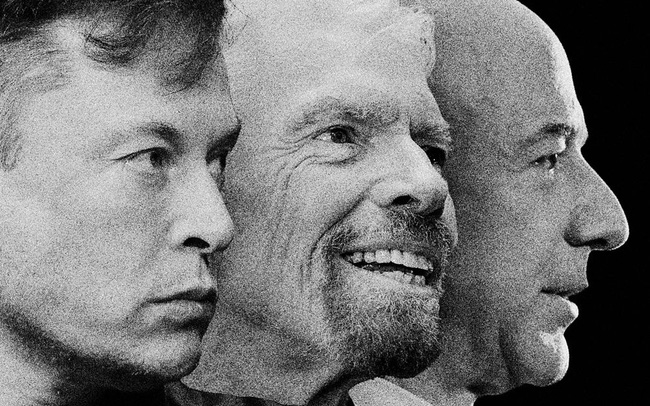Behind billionaires’ space flights: Not just travel, but a whole new economy!
- Tram Ho
Richard Branson, Jeff Bezos and Elon Musk are all billionaires who intend to or have flown into space. In the past, some rich people have taken similar trips, but Branson and Bezos not only paid for the ticket, they also invested in the ship. In the future, such people – if rich enough, they will no longer have to depend on government space ships when they want to leave Earth.
Some have praised the engineering and integrity of transporting a group of people to the edge of space and then safely returning to Earth, or the miracle of crossing the boundaries of the possible. .
However, much of this fact shows that instead of focusing their resources on helping with the hardships caused by the pandemic, or climate change or any of these crises, they spend more money. money for other things. The Earth was not intact. Perhaps, these billionaires should keep the spaceship for a few decades and focus more on a few immediate concerns.

A few decades ago, when the three billionaires’ aerospace companies were just getting started, many people said their goals were utopian. Currently, it is the critics who have too narrow a view, even though they are the policy makers. However, behind the flights of billionaires is a vast field of aerospace.
After decades, Earth’s orbit and beyond has been commercialized at an astonishing rate thanks to the development of private companies. The fact that Branson and Bezos are willing to go into space on their own ships is more than a confirmation that their ships are safe enough for them to experiment and expand their businesses themselves.
Even if Bezos has decided to withdraw from the event, others will continue to fly into space, and possibly thousands of people and tens of thousands of machines designed for those flights. What happens in the future will be one of the most important and economic stories of the next decade, whether or not Elon Musk actually settles on Mars.
Here are a few of the lesser-known stories of the private aerospace industry. The first was the listing of a company called Astra Space – backed by venture capitalists. They built an orbiting rocket in just a few years. The goal is to put the satellite into orbit every day.
Shortly after Astra went public with a valuation of $2.1 billion, satellite maker Planet Labs, which uses hundreds of “eyes” in the sky to take pictures of the Earth every day, also announced a similar plan. with a value of $2.8 billion. Meanwhile, Firefly Aerospace owns a rocket in California, waiting for the area to clear the ground to “take off”.

In addition, OneWeb and SpaceX also regularly launch satellites around the Earth for the purpose of high-speed internet access. Rocket Lab from New Zealand – a country that previously did not have a spacecraft, is planning missions to the moon and Venus.
Recently, the SPAC craze presents a particularly large opportunity for the private aerospace sector, including the above companies. Easier access to capital markets has helped them attract billions of dollars from investors into an industry once dependent on the government. Therefore, the number of satellites orbiting the Earth is expected to increase from about 3,400 to 50,000-100,000 over the next decade.
While the estimates above may vary slightly, the main message here remains the same: the private aerospace industry is flourishing. This month’s space race is just the beginning of a much bigger change.
To see how far the private aerospace industry has come, look at Decker Eveleth, who just a few weeks ago was a senior at Reed University. Last month, while searching for satellite images of weapons stockpiles and other military infrastructure, he discovered 100 ballistic missile silos in a desert region of northern China.
In addition, customers use a satellite network to monitor crop health, plant emissions and the health of tropical forests. SpaceX and OneWeb’s satellite internet services have the potential to serve billions of people who can’t access broadband otherwise. Therefore, it can be seen that billionaires like Branson or Bezos are only a relatively small part of the big picture of the private aerospace industry.
Of course, the risk factors that come from these companies still exist, for example profits are not guaranteed. Although businesses like SpaceX, Rocket Lab and Planet are valued at billions of dollars, they are not yet profitable thanks to space projects.
Refer to Bloomberg
Source : Genk
